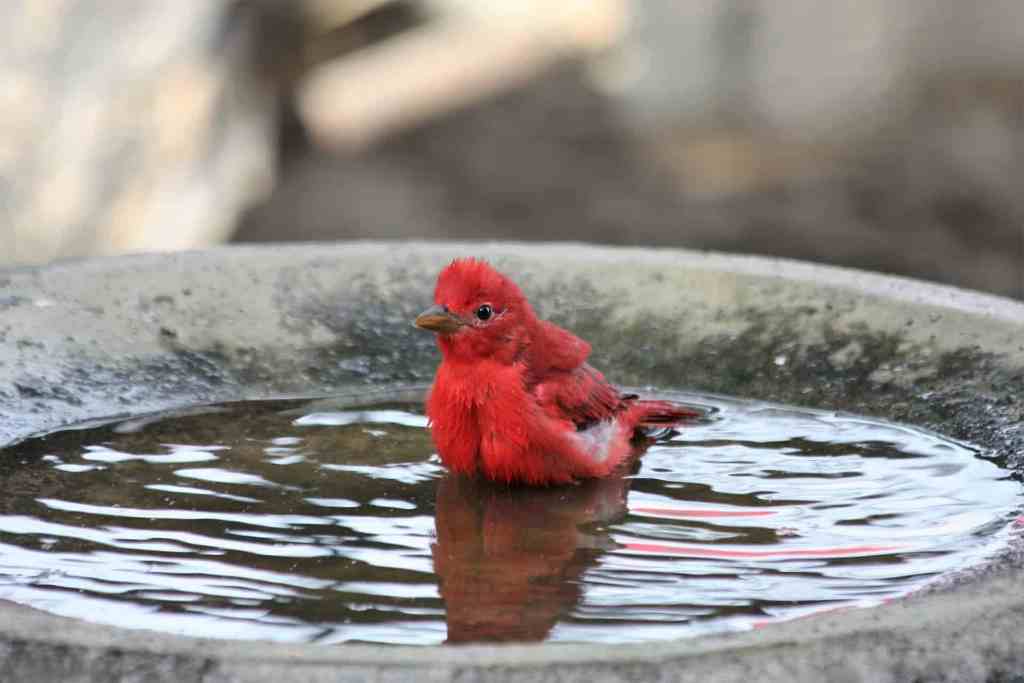Adding a bird bath to your yard is the easiest way to provide bathing and drinking water for birds.
Although having backyard feeders are a popular way to attract birds, providing a source of water is equally important for cultivating a wildlife friendly yard. By adding a bird bath or wildlife pond, you provide water necessary for birds, but also for many other species as well. Bird baths also add an aesthetically pleasing element to your yard. We will go over the basics of selecting and maintaining a bird bath. Also, how to create a backyard pond to attract birds, insects, amphibians, and other wildlife.
Bird Baths
As stated before, a bird bath to your yard is the easiest way to provide drinking and bathing water for birds. A bird bath does not need to be expensive or elaborate, and it can be made with materials found around the house. Bird baths require only a bit of care and maintenance, and they will attract birds and other animals as well.

Types of Bird Baths
There are two basic types of bird baths: aboveground baths, which can hang or are placed on a pedestal, and baths placed at or near ground level. The type of bath you select will determine the kinds of birds that you can possibly attract.
In general, birds that feed at bird feeders, such as the black-capped chickadee, house finch, and tufted titmouse, are most likely to use a bird bath that is located aboveground. A bird bath on the ground may attract less common backyard bird species, since this type of bath more closely mimics a natural stream or pond. Ground-level baths can also provide water for other animal species, such as chipmunks and squirrels. Having both types allows for you to provide water for the greatest variety of wildlife species.
Bird baths come in a variety of sizes and shapes, and they can be found at most garden, home, and pet stores. They range from about twenty dollars for a simple hanging terra-cotta or pedestal concrete bath to costing several hundred dollars for a cast iron or aluminum bath. However, you can also make an inexpensive bird bath from materials found around the house, such as the inverted lid of a garbage can or a large terra-cotta plant saucer. You can either place these directly on the ground or attach them to a rope or chains and hang from a tree branch.
Whether you buy or make a bird bath, you should keep in mind what is most attractive to a bird. Birds do not like slippery surfaces, and baths made out of materials such as glazed pottery or smooth plastics. They prefer a rough surface, like concrete or terra-cotta. If you already have a bird bath, or are making one, you should provide a nonstick surface by adding a few small rocks or even bathtub stickers. In addition, birds will only use a bath with shallow water, so do not add more than two to three inches of water at the deepest.
Location
Birds want a safe place to drink and bathe, so it is best to place your bird bath near shrubs or some low tree branches to allow them to escape quickly if aerial predators are nearby. In addition, a shady location will keep your bath from getting too hot in the summer and keep algae levels low. When you have a ground level bath, it is important to be aware of any cats that may be able to sneak up and attack the birds using your bath. If this is a potential problem in your yard, place your ground bath where the birds will be able to see a cat or other predator approaching, typically 10-15 feet from the nearest hiding spot. Finally, do not place your bird bath underneath bird feeders, because food and droppings will dirty the bath.

Care and Maintenance
Ideally, the water in your bird bath should be replaced every day to prevent dirt and debris from accumulating. Changing the water daily in the summer also prevents mosquito larvae from hatching in your bird bath, which is a concern where the West Nile virus is a threat. You should also scrub your bath with a brush, mild soap, and water every week to remove any algae that has appeared.
Winter
The winter months can be especially difficult for birds and other animals, since there is less water. Maintaining your bird bath throughout the winter will ensure a constant supply of fresh water for the birds. There are heated bird baths that will keep the water in your bath above freezing temperatures during the winter; there are also submersible heaters that you can place directly into the bath water. Both of these types will require a nearby electrical outlet.
Solar fountains and aerators are also an option for bird baths. These will work under sunny conditions but not when it is cloudy or overcast.






